

1. What is Patient Positioning?
Patient positioning is vital to a safe and effective surgical procedure. Proper patient positioning depends on the type and length of the procedure, anesthesia access to the patient, devices required, and other factors. In surgery, proper patient positioning provides optimal exposure to the surgical/treatment site and maintenance of the patient’s dignity by controlling unnecessary exposure. In most settings, positioning patients to provide airway management and ventilation, maintain body alignment, and provide physiologic safety.
2. Goals of Patient Positioning
- Provide patient comfort and safety.
- Maintaining patient dignity and privacy.
- Allows maximum visibility and access.
- Prevent soft tissue or musculoskeletal and other patient injuries
3. General positioning at a glance
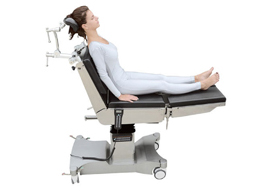 | Fowler's position Fowler's position, also known as the sitting position, is typically used for neurosurgery and shoulder surgeries. Fowler’s position is usually used in surgeries that involve neurosurgery or the shoulders The legs and knees should be relaxed and not overstretched. Raise the front and back stepwise, alternating between the two to reduce shear and friction forces. Once the patient has been placed into the sitting position, again assess the patient’s position to eliminate any forces that might have arisen during the positioning process. |
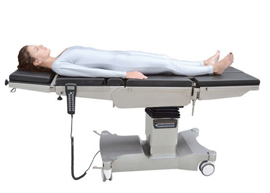 | Supine position The supine position is frequently used on procedures involving the anterior surface of the body (e.g., abdominal area, cardiac, thoracic area). Special attention should be given to leg positioning, ensuring that the knees and joints are not overstretched. The head and cervical spine should be relaxed. Careful arm placement can prevent nerve damage. |
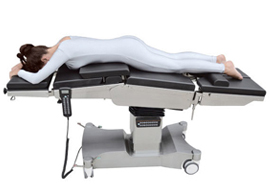 | Prone position The prone position is often used for neurosurgery, in most neck and spine surgeries. Used during spine surgery, the thorax must be placed on a pad with a large opening; this allows the stomach and breast to follow the breath and reduces intra-abdominal pressure. It is important to ensure that the blood vessels in the groin are not compressed. Knees should be bent slightly and well-padded. The head should be positioned so that the cervical spine is in a neutral position. Pillows with lateral cut-outs enable easy access to anesthesia tubes. |
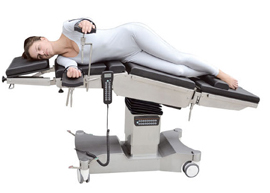 | Lateral position A patient may be positioned in a Lateral position during back, colorectal, kidney, and hip surgeries. It's also commonly used during thoracic and ENT surgeries, and neurosurgery. In lateral positioning, the patient must be secured to prevent rolling. Good padding for the legs and heels is recommended to relieve stress. The patient can be positioned on the motorized joints of the tabletop to give optimum access to the thorax or kidney area. Best practice recommends using a pillow that offers space for the ear. |
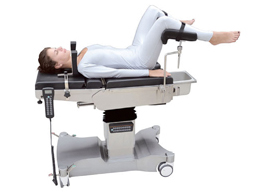 | Lithotomy position This position is typically used for gynecology, colorectal, urology, perineal, or pelvis procedures. This positioning requires that the pelvis is positioned to prevent a hollow back (lordosis) and to provide the largest possible supporting surface of the calf in the knee crutch. The popliteal fossa and heels should be freely positioned. The foot and knee should be positioned in line with the opposite shoulder. |
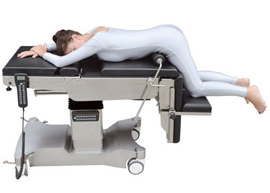 | Genucubital position / Knee elbow position For gynecological or rectal surgery, patients are anesthetized in the supine position, and then repositioned into a Trendelenburg position for surgery to prevent sliding. Positioning aids play an important role in this position. The thorax must be placed on a pad with a large opening to reduce intra-abdominal pressure and aid breathing. Protect the patella with a gel pad, and use additional padding at the hip. |
4. Support Devices for Patient Positioning
The followings are the devices or apparatus that can be used to help position the patient properly.
| - Arm Supports | - Waist support |
| - Body Restraints | - Pad Positioners |
| - Clamps & Sockets | - Patient Warming |
| - X-ray Tops | - Tabletop Pads |
| - Head Rests | - Disposable Surgical Accessories |
| - Leg Supports | - Lithotomy stirrup |
| - Shoulder support | - orthopedic traction |
References
The followings are the references and sources for this patient positioning study guide:
1. Ritchie, I. K. (2003). Positioning Patients for SurgeryBy Chris Servant & Shaun Purkiss Greenwich Medical Media ISBN 1841100528£ 22.50.
2. Miranda, A. B., Fogaça, A. R., Rizzetto, M., & Lopes, L. C. C. (2016). Surgical positioning: nursing care in the transoperative period. Rev SOBECC, 21(1), 52-8.
3. Berman, A., Snyder, S. J., Levett-Jones, T., Dwyer, T., Hales, M., Harvey, N., … & Stanley, D. (2018). Kozier and Erb’s Fundamentals of Nursing [4th Australian edition].4.
4.Rosdahl, C. B., & Kowalski, M. T. (Eds.). (2008). Textbook of basic nursing. Lippincott Williams & Wilkins.